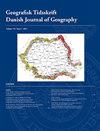使用基于元胞自动机的模型模拟城市增长的空间范围:以厄瓜多尔基多为例
IF 1.1
4区 社会学
Q4 ENVIRONMENTAL STUDIES
Geografisk Tidsskrift-Danish Journal of Geography
Pub Date : 2020-07-02
DOI:10.1080/00167223.2020.1823867
引用次数: 7
摘要
自20世纪80年代末以来,基多市的城市用地出现了相当大的扩张。这项研究产生了合理的城市增长情景,可以在城市规划中应用,并用于诸如交通需求预测或空气污染暴露等应用。我们开发了一种使用LUCIA模型绘制城市增长地图的方法。城市增长是根据土地利用图、监管约束、人口、邻近性、适宜性、主要道路的可达性、城市地区和次中心来估计的。该模型考虑了基多复杂的地形,根据地形的海拔定义了驱动力。该模型在2000-2016年期间进行了校准,并通过逐个单元和空间模式比较对2018年进行了令人满意的评估。我们分析了如果考虑实际和模拟城市土地附近的小误差是正确的,对结果评估的影响,发现一个单元格的距离精度提高了30%。我们应用该模型预测了基多在2016年至2040年间的城市增长。结果表明,如果目前的趋势继续下去,城市土地将增加84%,并在2025年左右趋于稳定。本文章由计算机程序翻译,如有差异,请以英文原文为准。
Modelling the spatial extent of urban growth using a cellular automata-based model: a case study for Quito, Ecuador
ABSTRACT Since the late 1980s, the city of Quito shows a considerable expansion of urban land. This study generates plausible scenarios of urban growth that can be applied within urban planning and used for applications, such as projections of transportation needs, or air pollution exposure. We develop a methodology to map urban growth using the LUCIA model. The urban growth is estimated based on land use maps, regulatory constraints, population, proximity, suitability, accessibility to main roads, urban areas, and sub-centralities. The model considers the complex topography of Quito by defining the driving forces according to the elevation of the terrain. The model is calibrated for the period 2000–2016 and satisfactorily evaluated for 2018 applying a cell by cell and spatial pattern comparison. We analyse the effect on the result assessment if small errors nearby the actual and simulated urban land are considered as correct, finding an increase of 30% in the accuracy for one cell of distance. We apply the model to predict the urban growth of Quito between 2016 and 2040. Results show that, if the current trend continues, the urban land will increase by 84% with a continuous fragmentation that stabilizes around the year 2025.
求助全文
通过发布文献求助,成功后即可免费获取论文全文。
去求助
来源期刊
CiteScore
5.20
自引率
0.00%
发文量
5
期刊介绍:
DJG is an interdisciplinary, international journal that publishes peer reviewed research articles on all aspects of geography. Coverage includes such topics as human geography, physical geography, human-environment interactions, Earth Observation, and Geographical Information Science. DJG also welcomes articles which address geographical perspectives of e.g. environmental studies, development studies, planning, landscape ecology and sustainability science. In addition to full-length papers, DJG publishes research notes. The journal has two annual issues. Authors from all parts of the world working within geography or related fields are invited to publish their research in the journal.

 求助内容:
求助内容: 应助结果提醒方式:
应助结果提醒方式:


